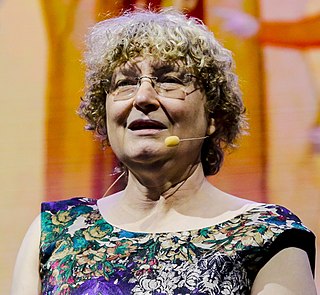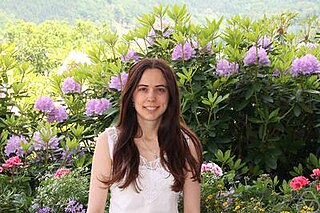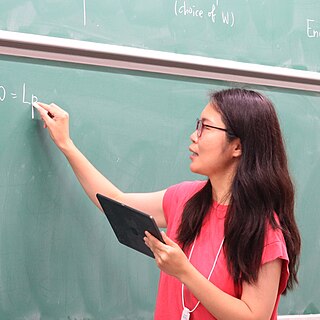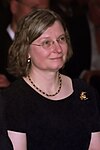
The American Mathematical Society (AMS) is an association of professional mathematicians dedicated to the interests of mathematical research and scholarship, and serves the national and international community through its publications, meetings, advocacy and other programs.

Baroness Ingrid Daubechies is a Belgian-American physicist and mathematician. She is best known for her work with wavelets in image compression.

Dusa McDuff FRS CorrFRSE is an English mathematician who works on symplectic geometry. She was the first recipient of the Ruth Lyttle Satter Prize in Mathematics, was a Noether Lecturer, and is a Fellow of the Royal Society. She is currently the Helen Lyttle Kimmel '42 Professor of Mathematics at Barnard College.

Claire Voisin is a French mathematician known for her work in algebraic geometry. She is a member of the French Academy of Sciences and holds the chair of algebraic geometry at the Collège de France.

Maryam Mirzakhani was an Iranian mathematician and a professor of mathematics at Stanford University. Her research topics included Teichmüller theory, hyperbolic geometry, ergodic theory, and symplectic geometry. On 13 August 2014, Mirzakhani was honored with the Fields Medal, the most prestigious award in mathematics, becoming the first woman to win the prize, as well as the first Iranian. The award committee cited her work in "the dynamics and geometry of Riemann surfaces and their moduli spaces". Mirzakhani was considered a leading force in the fields of hyperbolic geometry, topology and dynamics.
Joan Sylvia Lyttle Birman is an American mathematician, specializing in low-dimensional topology. She has made contributions to the study of knots, 3-manifolds, mapping class groups of surfaces, geometric group theory, contact structures and dynamical systems. Birman is research professor emerita at Barnard College, Columbia University, where she has been since 1973.

The Association for Women in Mathematics (AWM) is a professional society whose mission is to encourage women and girls to study and to have active careers in the mathematical sciences, and to promote equal opportunity for and the equal treatment of women and girls in the mathematical sciences. The AWM was founded in 1971 and incorporated in the state of Massachusetts. AWM has approximately 5200 members, including over 250 institutional members, such as colleges, universities, institutes, and mathematical societies. It offers numerous programs and workshops to mentor women and girls in the mathematical sciences. Much of AWM's work is supported through federal grants.
The Maryam Mirzakhani Prize in Mathematics is awarded by the U.S. National Academy of Sciences "for excellence of research in the mathematical sciences published within the past ten years."
Lawrence David Guth is a professor of mathematics at the Massachusetts Institute of Technology.

Hee Oh is a Korean American mathematician and the Abraham Robinson Professor of Mathematics at Yale University. She made contributions to dynamical systems, discrete subgroups of Lie groups, and their connections to geometry and number theory.
This is a timeline of women in mathematics.
Karen Ellen Smith is an American mathematician, specializing in commutative algebra and algebraic geometry. She completed her bachelor's degree in mathematics at Princeton University before earning her PhD in mathematics at the University of Michigan in 1993. Currently she is the Keeler Professor of Mathematics at the University of Michigan. In addition to being a researcher in algebraic geometry and commutative algebra, Smith with others wrote the textbook An Invitation to Algebraic Geometry.
Laura Grace DeMarco is a professor of mathematics at Harvard University, whose research concerns dynamical systems and complex analysis.

Abigail A. Thompson is an American mathematician. She works as a professor of mathematics at the University of California, Davis, where she specializes in knot theory and low-dimensional topology.
Ana Caraiani is a Romanian-American mathematician, who is a Royal Society University Research Fellow and Hausdorff Chair at the University of Bonn. Her research interests include algebraic number theory and the Langlands program.

Svetlana Yakovlevna Jitomirskaya is a mathematician working on dynamical systems and mathematical physics. She is a distinguished professor of mathematics at Georgia Tech and UC Irvine. She is best known for solving the ten martini problem along with mathematician Artur Avila.
Panagiota Daskalopoulos is a professor of mathematics at Columbia University whose research involves partial differential equations and differential geometry. At Columbia, she also serves as director of undergraduate studies for mathematics.
The Alice T. Schafer Mathematics Prize is given annually to an undergraduate woman for excellence in mathematics by the Association for Women in Mathematics (AWM). The prize, which carries a monetary award, is named for former AWM president and founding member Alice T. Schafer; it was first awarded in 1990.

Nina Holden is a Norwegian mathematician interested in probability theory and stochastic processes, including graphons, random planar maps, the Schramm–Loewner evolution, and their applications to quantum gravity. She was a Junior Fellow at the Institute for Theoretical Studies at ETH Zurich, and is currently an associate professor at the Courant Institute of Mathematical Sciences of New York University.

Jinyoung Park is a South Korean mathematician at the Courant Institute of Mathematical Sciences at New York University working in combinatorics and graph theory.






















